LINKSYS WUSB200 Wireless-G Business USB Adapter with RangeBooster User Manual book
LINKSYS LLC Wireless-G Business USB Adapter with RangeBooster book
LINKSYS >
Contents
- 1. Manual Part1
- 2. Manual Part2
Manual Part1
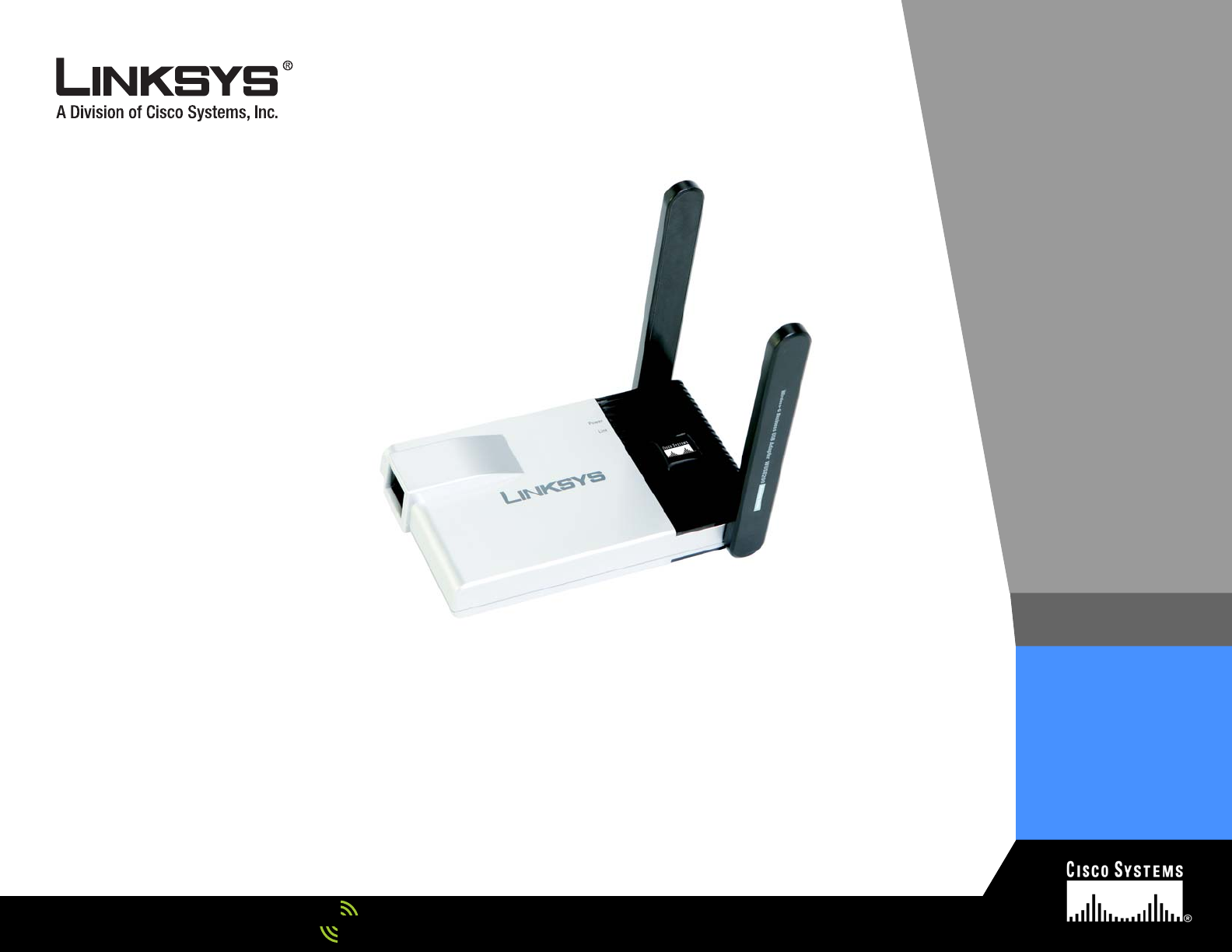
Model No.
Model No.
USER GUIDE
BUSINESS SERIES
Model No.
Model No.
Wireless-G
with Ports
Model No. WUSB200
4-portuter
Business USB Network Adapter
Wireless
with RangeBooster

Wireless-G Business USB Network Adapter with RangeBooster
Copyright and Trademarks
Specifications are subject to change without notice. Linksys is a registered trademark or trademark of Cisco
Systems, Inc. and/or its affiliates in the U.S. and certain other countries. Copyright © 2006 Cisco Systems, Inc. All
rights reserved. Other brands and product names are trademarks or registered trademarks of their respective
holders.
How to Use this User Guide
This user guide has been designed to make understanding networking with the USB Network Adapter easier than
ever. Look for the following items when reading this User Guide:
In addition to these symbols, there are definitions for technical terms that are presented like this:
Also, each figure (diagram, screenshot, or other image) is provided with a figure number and description, like
this:
Figure numbers and descriptions can also be found in the "List of Figures" section.
This exclamation point means there is a caution or warning and is
something that could damage your property or the USB Network Adapter.
word: definition.
This checkmark means there is a note of interest and is something you
should pay special attention to while using the USB Network Adapter.
This question mark provides you with a reminder about something
you might need to do while using the USB Network Adapter.
Figure 0-1: Sample Figure Description
WUSB200-UG-60107NC BW
WARNING: This product contains chemicals, including lead, known
to the State of California to cause cancer, and birth defects or other
reproductive harm. Wash hands after handling.

Wireless-G Business USB Network Adapter with RangeBooster
Table of Contents
Chapter 1: Introduction 1
Welcome 1
What’s in this User Guide? 2
Chapter 2: Planning your Wireless Network 4
Network Topology 4
Roaming 4
Network Layout 5
Chapter 3: Getting to Know the Wireless-G Business USB Network Adapter 6
The LED Indicator 6
Chapter 4: Setting up and Connecting the Wireless-G Business USB Network Adapter 7
Starting the Setup 7
Connecting the Adapter 8
Setting up the Adapter 9
Chapter 5: Using the Wireless Network Monitor 19
Accessing the Wireless Network Monitor 19
Using the Wireless Network Monitors 19
Link Information 19
Profiles 22
Create a New Profile 23
Editing a Profile 32
Site Survey 41
Troubleshooting 42
Administration 42
Chapter 6: The Administrative Functions in the Wireless Network Monitor 45
Accessing the Wireless Network Monitor 45
Using the Administrative Functions in the Wireless Network Monitor 45
Classification 46
Security Monitor 49
Appendix A: Troubleshooting 61
Common Problems and Solutions 61
Frequently Asked Questions 62
Appendix B: Windows XP Wireless Zero Configuration 65

Wireless-G Business USB Network Adapter with RangeBooster
Windows XP Wireless Zero Configuration 65
Appendix C: Wireless Security 68
Security Precautions 68
Security Threats Facing Wireless Networks 68
Appendix D: Windows Help 71
Appendix E: Glossary 72
Appendix F: Specifications 77
Appendix G: Warranty Information 79
Appendix H: Regulatory Information 80
Appendix I: Contact Information 86

Wireless-G Business USB Network Adapter with RangeBooster
List of Figures
Figure 3-1: LED 6
Figure 4-1: Setup Wizard’s Welcome Screen 7
Figure 4-2: Setup Wizard’s License Agreement 8
Figure 4-3: Connecting the Adapter 8
Figure 4-4: Available Wireless Network 9
Figure 4-5: WEP 10
Figure 4-6: WPA - Personal 10
Figure 4-7: WPA2 - Personal 11
Figure 4-8: Confirm New Settings 11
Figure 4-9: Congratulations 11
Figure 4-10: Creating a Profile 12
Figure 4-11: Network Settings - Wireless Mode 12
Figure 4-12: Ad-Hoc Mode Settings 13
Figure 4-13: Wireless Security - WEP 13
Figure 4-14: Wireless Security - WPA Personal 14
Figure 4-15: Wireless Security - WPA2 Personal 14
Figure 4-16: Wireless Security - WPA Enterprise-EAP-TLS 15
Figure 4-17: Wireless Security - WPA Enterprise-PEAP 15
Figure 4-18: Wireless Security - WPA2 Enterprise-EAP 16
Figure 4-19: Wireless Security - WPA2 Enterprise-PEAP 16
Figure 4-20: Wireless Security - RADIUS - EAP-TLS 17
Figure 4-21: Wireless Security - RADIUS - PEAP 17
Figure 4-22: Wireless Security - LEAP 18
Figure 4-23: Congratulations Screen 18
Figure 5-1: Wireless Network Monitor Icon 19
Figure 5-2: Link Information - Connection 19
Figure 5-3: Link Information - Wireless Network Status 20
Figure 5-4: Link Information - Wireless Network Statistics 21
Figure 5-5: Profiles 22
Figure 5-6: Import a Profile 22
Figure 5-7: Export a Profile 22
Figure 5-8: Creating a Profile - Available Wireless Network 23

Wireless-G Business USB Network Adapter with RangeBooster
Figure 5-9: Creating a Profile - WEP Key Needed 23
Figure 5-10: Creating a Profile - WPA-Personal 24
Figure 5-11: Creating a Profile - Congratulations 24
Figure 5-12: Creating a Profile - Manual Setup - Network Settings 25
Figure 5-13: Creating a Profile - Manual Setup - Wireless Mode 25
Figure 5-14: Creating a Profile - Manual Setup - Wireless Security - Disabled 26
Figure 5-15: Creating a Profile - Manual Setup - Wireless Security - WEP 26
Figure 5-16: Creating a Profile - Manual Setup - Wireless Security - WPA Personal 27
Figure 5-17: Creating a Profile - Manual Setup - Wireless Security - WPA2 Personal 27
Figure 5-18: Creating a Profile - Manual Setup - Wireless Security - WPA Enterprise - EAP-TLS 28
Figure 5-19: Creating a Profile - Manual Setup - Wireless Security - WPA Enterprise - PEAP 28
Figure 5-20: Creating a Profile - Manual Setup - Wireless Security - WPA2 Enterprise - EAP-TLS 29
Figure 5-21: Creating a Profile - Manual Setup - Wireless Security - WPA2 Enterprise - PEAP 29
Figure 5-22: Creating a Profile - Manual Setup - Wireless Security - RADIUS - EAP-TLS 30
Figure 5-23: Creating a Profile - Manual Setup - Wireless Security - RADIUS - PEAP 30
Figure 5-24: Creating a Profile - Manual Setup - Wireless Security - LEAP 31
Figure 5-25: Creating a Profile - Manual Setup - Confirm New Settings 31
Figure 5-26: Creating a Profile - Manual Setup - Congratulations 32
Figure 5-27: Editing a Profile 32
Figure 5-28: Editing a Profile - Wireless Mode 33
Figure 5-29: Editing a Profile - Ad Hoc Mode 33
Figure 5-30: Editing a Profile - Wireless Security 34
Figure 5-31: Editing a Profile - Wireless Security - WEP 34
Figure 5-32: Editing a Profile - Wireless Security - WPA Personal 35
Figure 5-33: Editing a Profile - Wireless Security -WPA2 Personal 35
Figure 5-34: Editing a Profile - Wireless Security - WPA Enterprise - EAP-TLS 36
Figure 5-35: Editing a Profile - Wireless Security - WPA Enterprise - PEAP 36
Figure 5-36: Editing a Profile - Wireless Security -WPA2 Enterprise - EAP-TLS 37
Figure 5-37: Editing a Profile - Wireless Security - WPA2 Enterprise - PEAP 37
Figure 5-38: Editing a Profile - Wireless Security - RADIUS - EAP-TLS 38
Figure 5-39: Editing a Profile - Wireless Security - RADIUS - PEAP 38
Figure 5-40: Editing a Profile - Wireless Security - LEAP 39
Figure 5-41: Editing a Profile - Network Settings 39
Figure 5-42: Editing a Profile - Confirm New Settings 40

Wireless-G Business USB Network Adapter with RangeBooster
Figure 5-43: Editing a Profile - Congratulations 40
Figure 5-44: Site Survey 41
Figure 5-45: Troubleshooting 42
Figure 5-46: Administration 42
Figure 5-47: Administration - Login Access Point Account 43
Figure 5-48: Administration - Modify Access Point Account 43
Figure 5-49: Administration - Security Monitor Account 44
Figure 6-1: Wireless Network Monitor Icon 45
Figure 6-2: Administration - Login Security Monitor Administration - Login Security Monitor Account 45
Figure 6-3: Classification 45
Figure 6-4: AP Classification 46
Figure 6-5: Client Classification 46
Figure 6-6: Trusted Mac Address 47
Figure 6-7: Allowed SSID Configuration 47
Figure 6-8: Allowed Vendor List Configuration 48
Figure 6-9: Allowed SSID Configuration 48
Figure 6-10: Allowed Channel Configuration 49
Figure 6-11: Security Monitor - Channel Usage 49
Figure 6-12: Security Monitor - AP Inventory 50
Figure 6-13: Security Monitor - Client Inventory 50
Figure 6-14: Security Monitor - Alerts Summary 51
Figure 6-15: Security Monitor - POP-UP Alert 51
Figure 6-16: Security Monitor - Alert List 52
Figure 6-17: Alert Details 52
Figure 6-18: Security Monitor - Alert Advice 53
Figure 6-19: Security Monitor - Windows Firewall Screen 60
Figure B-1: Wireless Network Monitor Icon 65
Figure B-2: Windows XP - Use Windows XP Wireless Configuration 65
Figure B-3: Windows XP Wireless Zero Configuration Icon 65
Figure B-4: Available Wireless Network 66
Figure B-5: No Wireless Security 66
Figure B-6: Network Connection - Wireless Security 67

1
Chapter 1: Introduction
Welcome
Wireless-G Business USB Network Adapter with RangeBooster
Chapter 1: Introduction
Welcome
Thank you for choosing the Wireless-G Business USB Network Adapter. Setting up your network and your
Wireless-G Business USB Network Adapter is easier than ever.
The Wireless-G USB Network Adapter is the simple way to add or upgrade wireless connectivity in your computer.
Just connect it into your computer's USB port and enjoy incredible high-speed wireless network access while not
having to run cable wires.
RangeBooster technology increases your wireless network's range up to two times, and its throughput by up to
35%. Unlike ordinary wireless technologies that are confused by signal reflections, RangeBooster uses two
smart receivers at each end to detect and decode reflected signals at distances where standard technologies
give up. You'll find that "dead spots" in the wireless coverage area are reduced, too.
But what does all of this mean?
PCs equipped with wireless cards and adapters can communicate without cumbersome cables. By sharing the
same wireless settings, within their transmission radius, they form a wireless network.
Once you're connected, you can keep in touch with your e-mail, access the Internet, and share files and other
resources such as printers and network storage with other computers on the network, wherever your work takes
you, without cables.
The Advanced security features makes this solution ideal for your business. Advanced wireless security using Wi-
Fi Protected Access™ (WPA2 Enterprise) with up to 256-bit encryption, and the new Wireless Security Monitoring
functionality gives your business the visibility and protection it needs. When used with a Linksys WAP200, the
Wireless Security Monitoring alerts you of possible wireless intruders and vulnerabilities in the wireless network
deployment.
The included Setup Wizard walks you through configuring the Adapter to your wireless network settings, step by
step. Use the instructions in this Guide to help you set up and connect the Adapter using the Setup Wizard. These
instructions should be all you need to get the most out of the Adapter.
adapter: a device that adds network functionality
to your PC.
network: a series of computers or devices
connected for the purpose of data sharing,
storage, and/or transmission between users.
encryption: encoding data transmitted in a network
802.11b: a wireless networking standard that
specifies a maximum data transfer rate of 11Mbps
and an operating frequency of 2.4GHz.
802.11g: a wireless networking standard that
specifies a maximum data transfer rate of 54Mbps
and an operating frequency of 2.4GHz.

2
Chapter 1: Introduction
What’s in this User Guide?
Wireless-G Business USB Network Adapter with RangeBooster
What’s in this User Guide?
This user guide covers the steps for setting up and using the Wireless-G Business USB Network Adapter.
• Chapter 1: Introduction
This chapter describes the Adapter’s applications and this User Guide.
• Chapter 2: Planning Your Wireless Network
This chapter discusses a few of the basics about wireless networking.
• Chapter 3: Getting to Know the Wireless-G Business USB Network Adapter
This chapter describes the physical features of the Adapter.
• Chapter 4: Setting up and Connecting the Wireless-G Business USB Network Adapter
This chapter instructs you on how to install and configure the Adapter.
• Chapter 5: Using the Wireless Network Monitor
This chapter shows you how to use the Adapter’s Wireless Network Monitor.
• Chapter 6: Administration Functions in the Network Monitor
This chapter shows you how to use the administration features of the Adapter’s Wireless Network Monitor.
• Appendix A: Troubleshooting
This appendix describes some problems and solutions, as well as frequently asked questions, regarding
installation and use of the Adapter.
• Appendix B: Windows XP Zero Configuration
This appendix describes how to use the Windows XP Zero Configuration.
• Appendix C: Wireless Security
This appendix discusses security issues regarding wireless networking and measures you can take to help
protect your wireless network.
• Appendix D: Windows Help
This appendix describes how you can use Windows Help for instructions about networking, such as installing
the TCP/IP protocol.
• Appendix E: Glossary
This appendix gives a brief glossary of terms frequently used in networking.
• Appendix F: Specifications
This appendix provides the Adapter’s technical specifications.

3
Chapter 1: Introduction
What’s in this User Guide?
Wireless-G Business USB Network Adapter with RangeBooster
• Appendix G: Warranty Information
This appendix supplies the Adapter’s warranty information.
• Appendix H: Regulatory Information
This appendix supplies the Adapter’s regulatory information.
• Appendix I: Contact Information
This appendix provides contact information for a variety of Linksys resources, including Technical Support.

4
Chapter 2: Planning your Wireless Network
Network Topology
Wireless-G Business USB Network Adapter with RangeBooster
Chapter 2: Planning your Wireless Network
Network Topology
A wireless network is a group of computers, each equipped with one wireless adapter. Computers in a wireless
network must be configured to share the same radio channel. Several PCs equipped with wireless cards or
adapters can communicate with each another to form an ad-hoc network.
Linksys wireless adapters also provide users access to a wired network when using an access point or wireless
router. An integrated wireless and wired network is called an infrastructure network. Each wireless PC in an
infrastructure network can talk to any computer in a wired network infrastructure via the access point or wireless
router.
An infrastructure configuration extends the accessibility of a wireless PC to a wired network, and can double the
effective wireless transmission range for two wireless adapter PCs. Since an access point is able to forward data
within a network, the effective transmission range in an infrastructure network can be doubled.
Roaming
Infrastructure mode also supports roaming capabilities for mobile users. Roaming means that you can move your
wireless PC within your network and the access points will pick up the wireless PC's signal, if they both share the
same channel and SSID.
Before you consider roaming, choose a feasible radio channel and optimum access point position. Proper access
point positioning combined with a clear radio signal will greatly enhance performance.
infrastructure: a wireless network that is
bridged to a wired network via an access point.
ad-hoc: a group of wireless devices
communicating directly with each other (peer-
to-peer) without the use of an access point.
roaming: the ability to take a wireless device
from one access point's range to another without
losing the connection.
ssid: your wireless network's name.
topology: the physical layout of a network.
access point: a device that allows wireless-
equipped computers and other devices to
communicate with a wired network

5
Chapter 2: Planning your Wireless Network
Network Layout
Wireless-G Business USB Network Adapter with RangeBooster
Network Layout
Linksys wireless access points and wireless routers have been designed for use with 802.11a, 802.11b, and
802.11g products. With 802.11g products communicating with the 802.11b standard and some products
incorporating both “a” and “g”, products using these standards can communicate with each other.
Access points and wireless routers are compatible with 802.11a, 802.11b and 802.11g adapters, such as the PC
Cards for your laptop computers, PCI Cards for your desktop PC, and USB Adapters for when you want to enjoy
USB connectivity.
When you wish to connect your wired network with your wireless network, the network ports on the access
points and wireless routers can be connected to Linksys switches or routers.
With these, and many other, Linksys products, your networking options are limitless. Go to the Linksys website at
www.linksys.com for more information about wireless products.
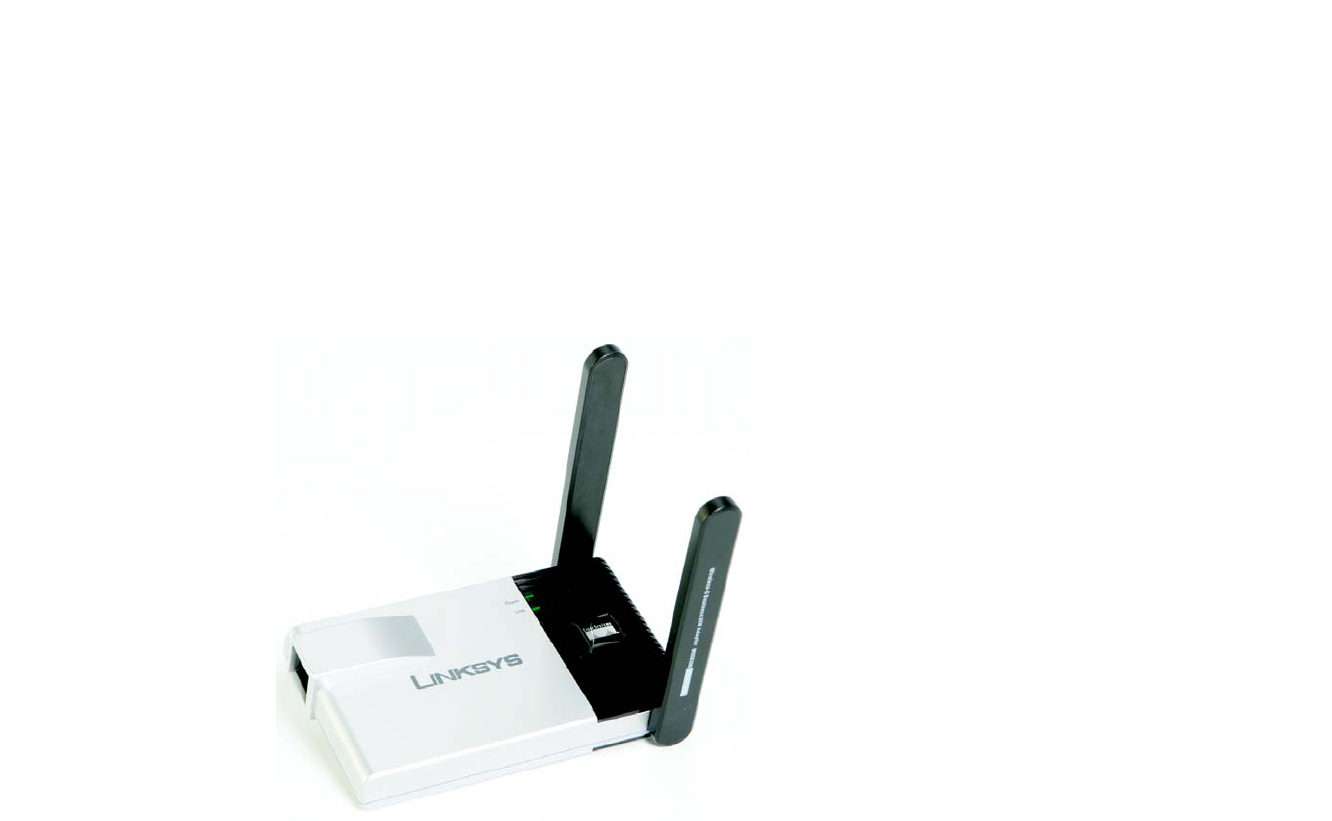
6
Chapter 3: Getting to Know the Wireless-G Business USB Network Adapter
The LED Indicators
Wireless-G Business USB Network Adapter with RangeBooster
Chapter 3: Getting to Know the Wireless-G Business USB
Network Adapter
The LED Indicators
The Network Adapter's LEDs display information about network activity.
Power Green. The Wireless LED lights up when the Adapter is powered on.
Link Green. The Link/Act LED lights up when the Adapter has an active connection.
Figure 3-1: LEDs

7
Chapter 4: Setting up and Connecting the Wireless-G Business USB Network Adapter
Starting the Setup
Wireless-G Business USB Network Adapter with RangeBooster
Chapter 4: Setting up and Connecting the Wireless-G
Business USB Network Adapter
Starting the Setup
The Wireless-G Business USB Network Adapter Setup Wizard will guide you through the installation procedure.
The Setup Wizard will install the driver and Wireless Network Monitor, as well as connect and configure the
Adapter.
Insert the Setup Wizard CD-ROM into your CD-ROM drive. The Setup Wizard should run automatically, and the
Welcome screen should appear. If it does not, click the Start button and choose Run. In the field that appears,
enter D:\setup.exe (if “D” is the letter of your CD-ROM drive).
On the Welcome screen, you have the following choices:
Click Here to Start- Click the Click Here to Start button to begin the software installation process.
User Guide - Click the User Guide button to open the PDF file of this User Guide.
Exit - Click the Exit button to exit the Setup Wizard.
1. To install the Adapter, click the Click Here to Start button on the Welcome screen.
Figure 4-1: Setup Wizard’s Welcome Screen
IMPORTANT: Do not connect the Adapter until you are instructed to
do so or the setup will not work correctly.

8
Chapter 4: Setting up and Connecting the Wireless-G Business USB Network Adapter
Connecting the Adapter
Wireless-G Business USB Network Adapter with RangeBooster
2. After reading the License Agreement, click the Next button if you agree and want to continue the installation,
or click the Cancel button to end the installation.
3. Windows will begin copying the files onto your PC.
Connecting the Adapter
1. Connect one end of the included USB cable to the Adapter’s USB port.
2. Connect the other end of the cable to one of the USB ports on your computer.
3. The Power LED should light up when the Adapter is plugged in.
4. Raise the antennas. Make sure the antennas point straight up into the air, at a 90º angle from the Adapter.
This will ensure optimum wireless operating range and performance.
5. Click Next. It may take a minute before the next screen appears.
Figure 4-3: Connecting the Adapter
Figure 4-2: Setup Wizard’s License Agreement

9
Chapter 4: Setting up and Connecting the Wireless-G Business USB Network Adapter
Setting up the Adapter
Wireless-G Business USB Network Adapter with RangeBooster
Setting up the Adapter
The next screen to appear will be the Available Wireless Network screen.
This screen provides two options for setting up the Adapter.
•Available Wireless Network. (For most users.) Use this option if you already have a network set up. The
networks available to this Adapter will be listed on this screen. You can choose one of these networks and
click the Connect button to connect to it. Click the Refresh button to update the Available Wireless Network
list.
•Manual Setup. If your network is not listed on this screen, select Manual Setup to set up the adapter
manually. This method of setting up the Adapter is intended for Advanced Users only.
The setup for each option is described, step by step, under the appropriate heading on the following pages.
Click Exit to close the Setup Wizard, if you wish to set up the Adapter later.
Figure 4-4: Available Wireless Network

10
Chapter 4: Setting up and Connecting the Wireless-G Business USB Network Adapter
Setting up the Adapter
Wireless-G Business USB Network Adapter with RangeBooster
Available Wireless Network
The available networks are listed in the table on the center of the screen by SSID. Select the wireless network you
wish to connect to and click the Connect button. (If you do not see your network listed, you can click the Refresh
button to bring the list up again.) If the network utilizes wireless security, you will need to configure security on
the Adapter. If not, you will be taken directly to the Congratulations screen.
1. If you have wireless security enabled on your network, continue to step 2. Only One of these security screens
will be shown. If you don’t have wireless security enabled, continue to step 3.
2. Wireless Security
If your network has WEP, WPA-Personal , or WPA2-Personal wireless security enabled, then that security
screen will appear. Continue to the screen for your wireless security.
WEP
If your network has the wireless security WEP (Wired Equivalent Privacy), RADIUS or LEAP enabled, this
screen will appear. For connecting with RADIUS or LEAP, click Connect, then continue to the next section
“Manual Setup” on page 12.
Security - Select WEP.
WEP - Select 64-bit or 128-bit.
Then enter a passphrase or WEP key.
Passphrase - Enter a passphrase in the Passphrase field, so a WEP key is automatically generated. The
passphrase is case-sensitive and should not be longer than 16 alphanumeric characters. It must match the
passphrase of your other wireless network devices and is compatible with Linksys wireless products only. (If
you have any non-Linksys wireless products, enter the WEP key manually on those products.)
WEP Key - The WEP key you enter must match the WEP key of your wireless network. For 64-bit encryption,
Figure 4-5: WEP
Figure 4-6: WPA - Personal
wpa (wi-fi protected access): a wireless security protocol
using TKIP (Temporal Key Integrity Protocol) encryption,
which can be used in conjunction with a RADIUS server.
encryption: encoding data transmitted in a network.
wep (wired equivalent privacy): a method of encrypting
network data transmitted on a wireless network for greater
security.

11
Chapter 4: Setting up and Connecting the Wireless-G Business USB Network Adapter
Setting up the Adapter
Wireless-G Business USB Network Adapter with RangeBooster
enter exactly 10 hexadecimal characters. For 128-bit encryption, enter exactly 26 hexadecimal characters.
Valid hexadecimal characters are “0” to “9” and “A” to “F”.
Then click Connect and proceed to Step 3.
WPA-Personal
If your network has the wireless security WPA-Personal (Wi-Fi Protected Access) enabled, this screen will
appear.
Passphrase - Enter a Passphrase, also called a Pre-shared Key, of 8-63 characters in the Passphrase field.
Then click Connect and proceed to Step 3.
WPA2-Personal
If your network has the wireless security WPA2-Personal enabled, this screen will appear.
Passphrase - Enter a Passphrase, also called a Pre-shared Key, of 8-63 characters in the Passphrase field.
Then click Connect and proceed to Step 3.
3. The Confirm New Settings screen will appear next and show the new settings. To save the new settings, click
the Save button.
Figure 4-9: Congratulations
Figure 4-7: WPA2 - Personal
Figure 4-8: Confirm New Settings

12
Chapter 4: Setting up and Connecting the Wireless-G Business USB Network Adapter
Setting up the Adapter
Wireless-G Business USB Network Adapter with RangeBooster
To edit the new settings, click the Back button. To exit the Manual Setup through the Wireless Network
Monitor, click Exit.
4. After the software has been successfully installed, the Congratulations screen will appear. Click Connect to
Network to connect to your network and return to the Link Information screen.
Click Return to Profile Screen to keep the current settings active and return to the Profiles screen.
For more information about the Wireless Network Monitor, refer to Chapter 5: Using the Wireless Network
Monitor.
Congratulations! The installation of the Wireless-G Business USB Network Adapter is complete.
To check the link information, search for available wireless networks, or make additional configuration
changes, proceed to Chapter 5: Using the Wireless Network Monitor.
Manual Setup
If your network is not listed with the available networks, you can use Manual Setup.
1. Click Manual Setup on the Available Wireless Network screen to set up the adapter manually.
2. The Network Settings screen from the Wireless Network Monitor will appear. If your network has a router or
other DHCP server, click the radio button next to Obtain network settings automatically (DHCP).
If your network does not have a DHCP server, click the radio button next to Specify network settings. Enter
an IP Address, Subnet Mask, Default Gateway, and DNS addresses appropriate for your network. You must
specify the IP Address and Subnet Mask on this screen. If you are unsure about the Default Gateway and DNS
addresses, leave these fields empty.
IP Address - This IP Address must be unique to your network.
Subnet Mask - The Adapter’s Subnet Mask must be the same as your wired network’s Subnet Mask.
Figure 4-10: Creating a Profile
Figure 4-11: Network Settings - Wireless Mode

13
Chapter 4: Setting up and Connecting the Wireless-G Business USB Network Adapter
Setting up the Adapter
Wireless-G Business USB Network Adapter with RangeBooster
Default Gateway - Enter the IP address of your network’s Gateway here.
DNS 1 and DNS 2 - Enter the DNS address of your wired Ethernet network here.
Click the Next button to continue, or click the Back button to return to the previous screen.
3. The Wireless Mode screen shows a choice of two wireless modes. Click the Infrastructure Mode radio
button if you want to connect to a wireless router or access point. Click the Ad-Hoc Mode radio button if you
want to connect to another wireless device directly without using a wireless router or access point. Enter the
SSID for your network.
Infrastructure Mode - Use this mode if you want to connect to a wireless router or access point.
Ad-Hoc Mode - Use this mode if you want to connect to another wireless device directly without using a
wireless router or access point.
SSID - This is the wireless network name that must be used for all the devices in your wireless network. It is
case-sensitive and should be a unique name to help prevent others from entering your network.
Click the Next button to continue, or click the Back button to return to the previous screen.
4. If you chose Infrastructure Mode, go to Step 5 now. If you chose Ad-Hoc Mode, the Ad-Hoc Mode Settings
screen will appear.
Select the correct operating channel for your wireless network. The channel you choose should match the
channel set on the other devices in your wireless network. If you are unsure about which channel to use, keep
the default setting.
Click the Next button. Click the Back button to change any settings.
5. If your wireless network does not have wireless security, select Disabled and then click the Next button to
continue. Proceed to Step 6.
If your wireless network has wireless security, select the method of security used: WEP, WPA/WPA2-
Personal, WPA/WPA2-Enterprise, RADIUS, or LEAP. WEP stands for Wired Equivalent Privacy, and WPA
Figure 4-12: Ad-Hoc Mode Settings
Figure 4-13: Wireless Security - WEP
wep (wired equivalent privacy): a method of encrypting
network data transmitted on a wireless network for greater
security.
encryption: encoding data transmitted in a network.

14
Chapter 4: Setting up and Connecting the Wireless-G Business USB Network Adapter
Setting up the Adapter
Wireless-G Business USB Network Adapter with RangeBooster
stands for Wi-Fi Protected Access. WPA uses a stronger security method than WEP and WPA2 defines an even
stronger encryption, authentication, and key management than WPA. RADIUS stands for Remote
Authentication Dial-In User Service. LEAP stands for Lightweight Extensible Authentication Protocol. It uses
username and password-based authentication between a wireless client and a RADIUS server. Click the Next
button to continue or the Back button to return to the previous screen.
Proceed to the appropriate section for your security method: WEP, WPA/WPA2-Personal, WPA/WPA2-
Enterprise, RADIUS, or LEAP.
WEP - Select 64-bit or 128-bit encryption
Passphrase - Enter a passphrase in the Passphrase field, so a WEP key is automatically generated. It is case-
sensitive and should not be longer than 16 alphanumeric characters. This passphrase must match the
passphrase of your other wireless network devices and is compatible with Linksys wireless products only. (If
you have any non-Linksys wireless products, enter the WEP key manually on those products.)
WEP Key - The WEP key you enter must match the WEP key of your wireless network. For 64-bit encryption,
enter exactly 10 hexadecimal characters. For 128-bit encryption, enter exactly 26 hexadecimal characters.
Valid hexadecimal characters are “0” to “9” and “A” to “F”.
Advanced Users
TX Key - The default transmit key number is 1. If your network’s access point or wireless router uses transmit
key number 2, 3, or 4, select the appropriate number from the TX Key drop-down box.
Authentication -The default is set to Auto, so it will auto-detect for Shared Key or Open System
authentication. For Shared Key authentication, both the sender and the recipient share a WEP key for
authentication. For Open System authentication, the sender and the recipient do not share a WEP key for
authentication. If you are not sure which authentication method to select, keep the default, Auto.
Click the Next button to continue, or click the Back button to return to the previous screen.
WPA Personal
WPA Personal offers two encryption methods, TKIP and AES, with dynamic encryption keys. WPA2 only uses
AES for encryption. Select TKIP or AES for encryption for WPA Personal. Then enter a Passphrase that is 8-63
characters in length.
Figure 4-14: Wireless Security - WPA Personal
wpa2 offers a stronger encryption than wpa by using the
AES (Advanced Encryption Standard) which is a block cipher
with block sizes of 128, 192 or 256 bits.
Figure 4-15: Wireless Security - WPA2 Personal
wpa (wi-fi protected access): a wireless security protocol
using TKIP (Temporal Key Integrity Protocol) encryption,
which can be used in conjunction with a RADIUS server.

15
Chapter 4: Setting up and Connecting the Wireless-G Business USB Network Adapter
Setting up the Adapter
Wireless-G Business USB Network Adapter with RangeBooster
Encryption - Select the type of algorithm you want to use, TKIP or AES, from the Encryption drop-down
menu.
Passphrase - Enter a Passphrase, also called a Pre-shared Key, of 8-63 characters in the Passphrase field.
Click the Next button to continue or the Back button to return to the previous screen.
WPA2 Personal
Enter a Pre-shared Key that is 8-63 characters in length.
Pre-shared Key - Enter a Pre-shared Key of 8-63 characters in the Pre-shared Key field.
Click the Next button to continue or the Back button to return to the previous screen.
Figure 4-16: Wireless Security - WPA Enterprise-EAP-
TLS
Figure 4-17: Wireless Security - WPA Enterprise-PEAP

16
Chapter 4: Setting up and Connecting the Wireless-G Business USB Network Adapter
Setting up the Adapter
Wireless-G Business USB Network Adapter with RangeBooster
WPA Enterprise
WPA Enterprise features WPA security used in coordination with a RADIUS server. (This should only be used
when a RADIUS server is connected to the Router.) WPA Enterprise offers two authentication methods, EAP-
TLS and PEAP, as well as two encryption methods, TKIP and AES, with dynamic encryption keys. WPA2
Enterprise offers two authentication methods, EAP-TLS and PEAP, but only AES encryption method can be
used.
Authentication - Select the authentication method your network is using, EAP-TLS or PEAP.
EAP-TLS
If you selected EAP-TLS, enter the login name of your wireless network in the Login Name field. Enter the
name of the authentication server in the Server Name field (this is optional). From the Certificate drop-down
menu, select the certificate you have installed to authenticate you on your wireless network. Select the type
of encryption, TKIP or AES, from the Encryption drop-down menu.
Click the Next button to continue or the Back button to return to the previous screen.
PEAP
If you selected PEAP, enter the login name of your wireless network in the Login Name field. Enter the
password of your wireless network in the Password field. Enter the name of the authentication server in the
Server Name field (this is optional).
Click the Next button to continue or the Back button to return to the previous screen.
Figure 4-19: Wireless Security - WPA2 Enterprise-PEAP
Figure 4-18: Wireless Security - WPA2 Enterprise-EAP

17
Chapter 4: Setting up and Connecting the Wireless-G Business USB Network Adapter
Setting up the Adapter
Wireless-G Business USB Network Adapter with RangeBooster
WPA2 Enterprise
WPA2 Enterprise features WPA2 security used in coordination with a RADIUS server. (This should only be used
when a RADIUS server is connected to the Router.) WPA2 Enterprise offers two authentication methods, EAP-
TLS and PEAP.
Authentication - Select the authentication method your network is using, EAP-TLS or PEAP.
EAP-TLS
If you selected EAP-TLS, enter the login name of your wireless network in the Login Name field. Enter the
name of the authentication server in the Server Name field (this is optional). From the Certificate drop-down
menu, select the certificate you have installed to authenticate you on your wireless network.
Click the Next button to continue or the Back button to return to the previous screen.
PEAP
If you selected PEAP, enter the login name of your wireless network in the Login Name field. Enter the
password of your wireless network in the Password field. Enter the name of the authentication server in the
Server Name field (this is optional). From the Certificate drop-down menu, select the certificate you have
installed to authenticate you on your wireless network; if you want to use any certificate, keep the default
setting, Trust Any. Then select the authentication method used inside the PEAP tunnel.
Click the Next button to continue or the Back button to return to the previous screen.
Figure 4-20: Wireless Security - RADIUS - EAP-TLS
Figure 4-21: Wireless Security - RADIUS - PEAP

18
Chapter 4: Setting up and Connecting the Wireless-G Business USB Network Adapter
Setting up the Adapter
Wireless-G Business USB Network Adapter with RangeBooster
RADIUS
RADIUS features use of a RADIUS server. (This should only be used when a RADIUS server is connected to the
Router.) RADIUS offers two authentication types: EAP-TLS and PEAP.
Authentication - Select the authentication method your network is using, EAP-TLS or PEAP.
EAP-TLS
If you selected EAP-TLS, enter the login name of your wireless network in the Login Name field. Enter the
name of the authentication server in the Server Name field (this is optional). From the Certificate drop-down
menu, select the certificate you have installed to authenticate you on your wireless network.
Click the Next button to continue or the Back button to return to the previous screen.
PEAP
If you selected PEAP, enter the login name of your wireless network in the Login Name field. Enter the
password of your wireless network in the Password field. Enter the name of the authentication server in the
Server Name field (this is optional). From the Certificate drop-down menu, select the certificate you have
installed to authenticate you on your wireless network; if you want to use any certificate, keep the default
setting, Trust Any. Then select the authentication method used inside the PEAP tunnel.
Click the Next button to continue or the Back button to return to the previous screen.
LEAP
Lightweight Extensible Authentication Protocol is a mutual authentication method that uses a user name and
password based system.
Login method - Select the login method your network is using, Manual Login or Windows Login.
If you select manual login, enter the username and password in the username and password field
accordingly. Enter the password again in the confirm filed.
6. The Congratulations screen will appear next. Click Connect to Network to implement the new settings and
return to the Link Information screen. Click Return to Profile screen to return to the Creating a Profile
screen.
Congratulations! Your manual setup through the Wireless Network Monitor is complete.
Figure 4-22: Wireless Security - LEAP
Figure 4-23: Congratulations Screen

19
Chapter 5: Using the Wireless Network Monitor
Accessing the Wireless Network Monitor
Wireless-G Business USB Network Adapter with RangeBooster
Chapter 5: Using the Wireless Network Monitor
Use the Wireless Network Monitor to check the link information, set up profiles of your wireless settings, search
for available wireless networks, troubleshoot your wireless connections, or administer the accounts that hold
privileges to access the Security Monitor.
Accessing the Wireless Network Monitor
After installing the Adapter, the Wireless Network Monitor icon will appear in the system tray of your computer. If
the Wireless Network Monitor is enabled, then the icon will be green. If the Wireless Network Monitor is disabled
or the Adapter is not connected, then the icon will be gray.
Using the Wireless Network Monitors
The opening screen of the Wireless Network Monitor is the Link Information screen. From this screen, you can
find out how strong the current wireless signal is and how good the connection’s quality is. You can also perform
configuration changes or create connection profiles by clicking the Profiles tab. To view the available wireless
networks, click the Site Survey tab. To troubleshoot the current connections or view the FAQ pages, click the
Troubleshooting tab. To perform the administrative tasks of the account information or specify email alert
addresses, click the Administration tab.
Link Information
The Connection screen of the Link Information tab displays signal strength and link quality information of the
current connection. It also provides tabs to click for additional connection information.
Signal Strength - The Signal Strength bar indicates signal strength from low to high; low is red, medium is
yellow and high is green.
Link Quality - The Link Quality bar indicates the quality of the wireless network connection from low to high; low
is red, medium is yellow and high is green.
Click the Status or Statistics tabs to view additional information about the wireless network connection.
Figure 5-1: Wireless Network Monitor Icon
Figure 5-2: Link Information - Connection

20
Chapter 5: Using the Wireless Network Monitor
Link Information
Wireless-G Business USB Network Adapter with RangeBooster
Status
Click the Status tab to view the Wireless Network Status screen. The Status screen provides information on your
current network settings.
Status- This shows the status of the connection.
SSID - Service Set Identifier, a 32-character unique identifier attached to the header of packets sent over a
WLAN. This is the unique name used to identify a network.
Wireless Mode - The mode of the wireless network currently in use is displayed here.
Transfer Rate - This shows the speed at which your wireless network transmits.
Channel - This displays the channel used by your network.
Security - The status of the wireless security feature is displayed here.
Authentication - This is your wireless network’s authentication method.
IP Address - The IP Address of the Adapter is displayed here.
Subnet Mask - The Subnet Mask of the Adapter is shown here.
Default Gateway - The Default Gateway address of the Adapter is displayed here.
DNS - This is the DNS (Domain Name Service) address of the Adapter.
DHCP - This shows the status of the DHCP server.
MAC Address- The MAC address of the wireless network’s access point or wireless router is shown here.
Click the Statistics tab to view the Wireless Network Statistics screen. Click the Connection button to return to
the initial Link Information screen. Click the Save to Profile button to save the currently active connection
settings to a profile.
Figure 5-3: Link Information - Wireless Network Status

21
Chapter 5: Using the Wireless Network Monitor
Link Information
Wireless-G Business USB Network Adapter with RangeBooster
Statistics
The Statistics screen provides statistics on your current network settings.
Transmit Rate - This is the data transfer rate of the current connection. (In Auto mode, the Adapter dynamically
shifts to the fastest data transfer rate possible at any given time.)
Receive Rate - This is the rate at which data is received.
Packets Received - This shows the packets received by the Adapter, in real time, since connecting to the
wireless network or since the Clear Counters button was last pressed.
Packets Transmitted - This shows the packets transmitted from the Adapter, in real time, since connecting to
the wireless network or since the Clear Counters button was last pressed.
Bytes Received - This shows the bytes received by the Adapter, in real time, since connecting to the wireless
network or since the Clear Counters button was last pressed.
Bytes Transmitted - This shows the bytes transmitted by the Adapter, in real time, since connecting to the
wireless network or since the Clear Counters button was last pressed.
Driver Version - This shows the version of the Adapter’s driver.
Signal Strength - This is the intensity of the wireless signal received by the Adapter.
Transmit Power - This is the power at which the Adapter transmits.
Total Up Time - This indicates the cumulative total of the Adapter’s connection time.
Signal Strength - The Signal Strength bar indicates the signal strength.
Link Quality - The Link Quality bar indicates the quality of the wireless network connection.
Click the Connection button to return to the initial Link Information screen. Click the Status button to go to the
Wireless Network Status screen. Click the Save to Profile button to save the currently active connection settings
to a profile. Click the Clear Counters button to reset the statistics counter.
Figure 5-4: Link Information - Wireless Network
Statistics

22
Chapter 5: Using the Wireless Network Monitor
Profiles
Wireless-G Business USB Network Adapter with RangeBooster
Profiles
The Profiles screen lets you save different configuration profiles for different network setups. The table on the left
displays a list of available profiles with their profile names and SSIDs.
Profile - The name of the profile is displayed here.
SSID - The SSID or unique name of the wireless network is displayed here.
Profile Information
For each profile selected, the following are listed:
Wireless Mode - This is the mode of the wireless network currently in use.
Transfer Rate - The data transfer rate of the current connection is shown here.
Channel - This is the channel to which the wireless network devices are set.
Authentication - The authentication setting for the network is shown here.
Encryption - The status of the wireless security feature is displayed here.
Connect - To connect to a wireless network using a specific profile, select the profile, and click Connect.
New - Click the New button to create a new profile. See the next section, “Create a New Profile,” for detailed
instructions.
Edit - Select the profile you want to change, and then click the Edit button. See the section, “Edit a New Profile,”
for detailed instructions.
Import - Click the Import button to import a profile that has been saved in another location. Select the
appropriate file, and click the Open button.
Export - Select the profile you want to save in a different location, and click the Export button. Direct Windows to
the appropriate folder, and click the Save button.
Delete - Select the profile you want to delete, and then click the Delete button.
NOTE: If you want to export more than one profile, you must export them one at a time.
NOTE: The default profile cannot be deleted.
Figure 5-5: Profiles
Figure 5-6: Import a Profile
Figure 5-7: Export a Profile

23
Chapter 5: Using the Wireless Network Monitor
Create a New Profile
Wireless-G Business USB Network Adapter with RangeBooster
Create a New Profile
When you click the New button on the Profiles screen, you will need to enter a name for your new profile and
click OK, then the Available Wireless Network screen appears.
This screen provides two options for setting up the Adapter.
•Available Wireless Network. (For most users.) Use this option if you already have a network set up. The
networks available to this Adapter will be listed on this screen. You can choose one of these networks and
click the Connect button to connect to it. Click the Refresh button to update the Available Wireless Network
list.
•Manual Setup. If your network is not listed on this screen, select Manual Setup to set up the adapter
manually. This method of setting up the Adapter is intended for advanced users only.
The setup for each option is described under the appropriate heading on the following pages.
Click Exit to return to the Profiles screen.
Available Wireless Network
The available networks are listed by SSID. Select the wireless network you wish to connect to and click the
Connect button. (If your network is not listed, you can click the Refresh button to bring the list up again.)
If the network utilizes wireless security, you will need to configure security on the Adapter. If not, you will be
taken directly to the Congratulations screen.
1. If you have wireless security enabled on your network, continue to step 2. One of these security screens will
be shown. If you don’t have wireless security enabled, continue to step 3.
2. If your network has WEP, WPA Personal, or WPA2 Personal wireless security enabled, then that security
screen will appear. Continue to the screen for your wireless security.
• WEP (Wired Equivalent Privacy)
If your network has the wireless security WEP (Wired Equivalent Privacy), this screen will appear. You
must enter the same security settings used on your network.
Select 64-bit or 128-bit WEP encryption, then enter a passphrase or WEP key.
Figure 5-8: Creating a Profile - Available Wireless
Network
Figure 5-9: Creating a Profile - WEP Key Needed

24
Chapter 5: Using the Wireless Network Monitor
Create a New Profile
Wireless-G Business USB Network Adapter with RangeBooster
Passphrase - Enter a passphrase in the Passphrase field, to automatically generate a WEP key. The
passphrase is case-sensitive and should not be longer than 16 alphanumeric characters. It must match
the passphrase of your other wireless network devices and is compatible with Linksys wireless products
only. (If you have any non-Linksys wireless products, enter the WEP key manually on those products.)
WEP Key - The WEP key you enter must match the WEP key of your wireless network. For 64-bit
encryption, enter exactly 10 hexadecimal characters. For 128-bit encryption, enter exactly 26
hexadecimal characters. Valid hexadecimal characters are “0” to “9” and “A” to “F”.
Then click Connect and proceed to Step 3.
•WPA Personal
If your network has the wireless security WPA Personal (Wi-Fi Protected Access) enabled, this screen will
appear. You must enter the same security settings used on your network.
Passphrase - Enter a Passphrase, also called a Pre-shared Key, of 8-63 characters in the Passphrase
field.
Then click Connect and proceed to Step 3.
•WPA2 Personal
If your network has the wireless security WPA2 Personal enabled, this screen will appear. You must enter
the same security settings used on your network.
Passphrase - Enter a Passphrase, also called a Pre-shared Key, of 8-63 characters in the Passphrase
field.
Then click Connect and proceed to Step 3.
3. After the software has been successfully installed, the Congratulations screen will appear. Click Connect to
Network to connect to your network, implement the new settings, and return to the Link Information screen.
Congratulations! The profile has been successfully configured. Figure 5-11: Creating a Profile - Congratulations
Figure 5-10: Creating a Profile - WPA-Personal

25
Chapter 5: Using the Wireless Network Monitor
Create a New Profile
Wireless-G Business USB Network Adapter with RangeBooster
Manual Setup
If your network is not listed with the available networks, you can use Manual Setup.
1. Click Manual Setup on the Available Wireless Network screen to set up the adapter manually.
2. The Network Settings screen will appear. If your network has a router or other DHCP server, select Obtain
network settings automatically (DHCP).
If your network does not have a DHCP server, select Specify network settings. Enter an IP Address, Subnet
Mask, Default Gateway, and DNS addresses appropriate for your network. You must specify the IP Address
and Subnet Mask on this screen. If you are unsure about the Default Gateway and DNS addresses, leave these
fields empty.
IP Address - This IP Address must be unique to your network.
Subnet Mask - The Adapter’s Subnet Mask must be the same as your wired network’s Subnet Mask.
Default Gateway - Enter the IP address of your network’s Gateway here.
DNS 1 and DNS 2 - Enter the DNS address of your wired Ethernet network here.
Click the Next button to continue, or click the Back button to return to the previous screen.
3. The Wireless Mode screen shows a choice of two wireless modes. Select Infrastructure Mode if you want to
connect to a wireless router or access point. Select Ad-Hoc Mode, if you want to connect to another wireless
device directly without using a wireless router or access point. Enter the SSID for your network.
Infrastructure Mode - Use this mode if you want to connect to a wireless router or access point.
Ad-Hoc Mode - Use this mode if you want to connect to another wireless device directly without using a
wireless router or access point.
SSID - This is the wireless network name that must be used for all the devices in your wireless network. It is
case- sensitive and should be a unique name to help prevent others from entering your network.
Click the Next button to continue, or click the Back button to return to the previous screen.
Figure 5-12: Creating a Profile - Manual Setup -
Network Settings
Figure 5-13: Creating a Profile - Manual Setup -
Wireless Mode

26
Chapter 5: Using the Wireless Network Monitor
Create a New Profile
Wireless-G Business USB Network Adapter with RangeBooster
4. If you chose Infrastructure Mode, go to Step 5 now. If you chose Ad-Hoc Mode, the Ad-Hoc Mode Settings
screen will appear.
Select the correct operating channel for your wireless network. The channel you choose should match the
channel set on the other devices in your wireless network. If you are unsure about which channel to use, keep
the default setting.
Click the Next button. Click the Back button to change any settings.
5. If your wireless network doesn’t have wireless security, select Disabled and then click the Next button to
continue. Proceed to Step 6.
If your wireless network has wireless security, select the method of security used: WEP, WPA/WPA2
Personal, WPA/WPA2 Enterprise, RADIUS or LEAP. WEP stands for Wired Equivalent Privacy, and WPA
stands for Wi-Fi Protected Access. WPA uses a stronger security method than WEP and WPA2 defines an even
stronger encryption, authentication, and key management than WPA. RADIUS stands for Remote
Authentication Dial-In User Service. LEAP stands for Lightweight Extensible Authentication Protocol. It uses
username and password-based authentication between a wireless client and a RADIUS server. Click the Next
button to continue or the Back button to return to the previous screen.
Proceed to the appropriate section for your security method: WEP, WPA/WPA2-Personal, WPA/WPA2-
Enterprise, RADIUS, or LEAP.
WEP
WEP - Select 64-bit or 128-bit encryption
Passphrase - Enter a passphrase in the Passphrase field, so a WEP key is automatically generated. It is case-
sensitive and should not be longer than 16 alphanumeric characters. This passphrase must match the
passphrase of your other wireless network devices and is compatible with Linksys wireless products only. (If
you have any non-Linksys wireless products, enter the WEP key manually on those products.)
WEP Key - The WEP key you enter must match the WEP key of your wireless network. For 64-bit encryption,
enter exactly 10 hexadecimal characters. For 128-bit encryption, enter exactly 26 hexadecimal characters.
Valid hexadecimal characters are “0” to “9” and “A” to “F”.
Advanced Users
TX Key - The default transmit key number is 1. If your network’s access point or wireless router uses transmit
key number 2, 3, or 4, select the appropriate number from the TX Key drop-down box.
wep (wired equivalent privacy): a method of encrypting network
data transmitted on a wireless network for greater security.
wpa (wi-fi protected access): a wireless security protocol using
TKIP (Temporal Key Integrity Protocol) encryption, which can be
used in conjunction with a RADIUS server.
wpa2 offers a stronger encryption than wpa by using the AES
(Advanced Encryption Standard) which is a block cipher with
block sizes of 128, 192 or 256 bits.
Figure 5-15: Creating a Profile - Manual Setup -
Wireless Security - WEP
Figure 5-14: Creating a Profile - Manual Setup -
Wireless Security - Disabled

27
Chapter 5: Using the Wireless Network Monitor
Create a New Profile
Wireless-G Business USB Network Adapter with RangeBooster
Authentication -The default is set to Auto, so it will auto-detect for Shared Key or Open System
authentication. For Shared Key authentication, both the sender and the recipient share a WEP key for
authentication. For Open System authentication, the sender and the recipient do not share a WEP key for
authentication. If you are not sure which authentication method to select, keep the default, Auto.
Click the Next button to continue, or click the Back button to return to the previous screen.
WPA Personal
WPA Personal offers two encryption methods, TKIP and AES, with dynamic encryption keys. WPA2 only uses
AES for encryption. Select TKIP or AES for encryption for WPA Personal. Then enter a Passphrase that is 8-63
characters in length.
Encryption - Select the type of algorithm you want to use, TKIP or AES, from the Encryption drop-down
menu.
Passphrase - Enter a Passphrase, also called a Pre-shared Key, of 8-63 characters in the Passphrase field.
Click the Next button to continue or the Back button to return to the previous screen.
WPA2 Personal
Enter a Pre-shared Key that is 8-63 characters in length.
Pre-shared Key - Enter a Pre-shared Key of 8-63 characters in the Pre-shared Key field.
Click the Next button to continue or the Back button to return to the previous screen.
Figure 5-16: Creating a Profile - Manual Setup -
Wireless Security - WPA Personal
Figure 5-17: Creating a Profile - Manual Setup -
Wireless Security - WPA2 Personal

28
Chapter 5: Using the Wireless Network Monitor
Create a New Profile
Wireless-G Business USB Network Adapter with RangeBooster
WPA Enterprise
WPA Enterprise features WPA security used in coordination with a RADIUS server. (This should only be used
when a RADIUS server is connected to the Router.) WPA Enterprise offers two authentication methods, EAP-
TLS and PEAP, as well as two encryption methods, TKIP and AES, with dynamic encryption keys. WPA2
Enterprise offers two authentication methods, EAP-TLS and PEAP, but only AES encryption method is used.
Authentication - Select the authentication method your network is using, EAP-TLS or PEAP.
EAP-TLS
If you selected EAP-TLS, enter the login name of your wireless network in the Login Name field. Enter the
name of the authentication server in the Server Name field (this is optional). From the Certificate drop-down
menu, select the certificate you have installed to authenticate you on your wireless network. Select the type
of encryption, TKIP or AES, from the Encryption drop-down menu.
Click the Next button to continue or the Back button to return to the previous screen.
PEAP
If you selected PEAP, enter the login name of your wireless network in the Login Name field. Enter the
password of your wireless network in the Password field. Enter the name of the authentication server in the
Server Name field (this is optional). Then select the authentication method used inside the PEAP tunnel.
Select the type of encryption, TKIP or AES, from the Encryption drop-down menu.
Click the Next button to continue or the Back button to return to the previous screen.
Figure 5-18: Creating a Profile - Manual Setup -
Wireless Security - WPA Enterprise - EAP-TLS
Figure 5-19: Creating a Profile - Manual Setup -
Wireless Security - WPA Enterprise - PEAP

29
Chapter 5: Using the Wireless Network Monitor
Create a New Profile
Wireless-G Business USB Network Adapter with RangeBooster
WPA2 Enterprise
WPA2 Enterprise features WPA2 security used in coordination with a RADIUS server. (This should only be used
when a RADIUS server is connected to the Router.) WPA2 Enterprise offers two authentication methods, EAP-
TLS and PEAP.
Authentication - Select the authentication method your network is using, EAP-TLS or PEAP.
EAP-TLS
If you selected EAP-TLS, enter the login name of your wireless network in the Login Name field. Enter the
name of the authentication server in the Server Name field (this is optional). From the Certificate drop-down
menu, select the certificate you have installed to authenticate you on your wireless network.
Click the Next button to continue or the Back button to return to the previous screen.
PEAP
If you selected PEAP, enter the login name of your wireless network in the Login Name field. Enter the
password of your wireless network in the Password field. Enter the name of the authentication server in the
Server Name field (this is optional).
Click the Next button to continue or the Back button to return to the previous screen.
Figure 5-21: Creating a Profile - Manual Setup -
Wireless Security - WPA2 Enterprise - PEAP
Figure 5-20: Creating a Profile - Manual Setup -
Wireless Security - WPA2 Enterprise - EAP-TLS

30
Chapter 5: Using the Wireless Network Monitor
Create a New Profile
Wireless-G Business USB Network Adapter with RangeBooster
RADIUS
RADIUS features use of a RADIUS server. (This should only be used when a RADIUS server is connected to the
Router.) RADIUS offers two authentication types: EAP-TLS and PEAP.
Authentication - Select the authentication method your network is using, EAP-TLS or PEAP.
EAP-TLS
If you selected EAP-TLS, enter the login name of your wireless network in the Login Name field. Enter the
name of the authentication server in the Server Name field (this is optional). From the Certificate drop-down
menu, select the certificate you have installed to authenticate you on your wireless network.
Click the Next button to continue or the Back button to return to the previous screen.
PEAP
If you selected PEAP, enter the login name of your wireless network in the Login Name field. Enter the
password of your wireless network in the Password field. Enter the name of the authentication server in the
Server Name field (this is optional).
Click the Next button to continue or the Back button to return to the previous screen.
Figure 5-22: Creating a Profile - Manual Setup -
Wireless Security - RADIUS - EAP-TLS
Figure 5-23: Creating a Profile - Manual Setup -
Wireless Security - RADIUS - PEAP

31
Chapter 5: Using the Wireless Network Monitor
Create a New Profile
Wireless-G Business USB Network Adapter with RangeBooster
LEAP
Lightweight Extensible Authentication Protocol is a mutual authentication method that uses a username and
password based system.
Enter the username and password in their fields. Enter the password again in the Confirm filed.
6. The Confirm New Settings screen will appear next and show the new settings. To save the new settings, click
the Save button.
To edit the new settings, click the Back button. To exit the Manual Setup through the Wireless Network
Monitor, click Exit.
Figure 5-24: Creating a Profile - Manual Setup -
Wireless Security - LEAP
Figure 5-25: Creating a Profile - Manual Setup -
Confirm New Settings
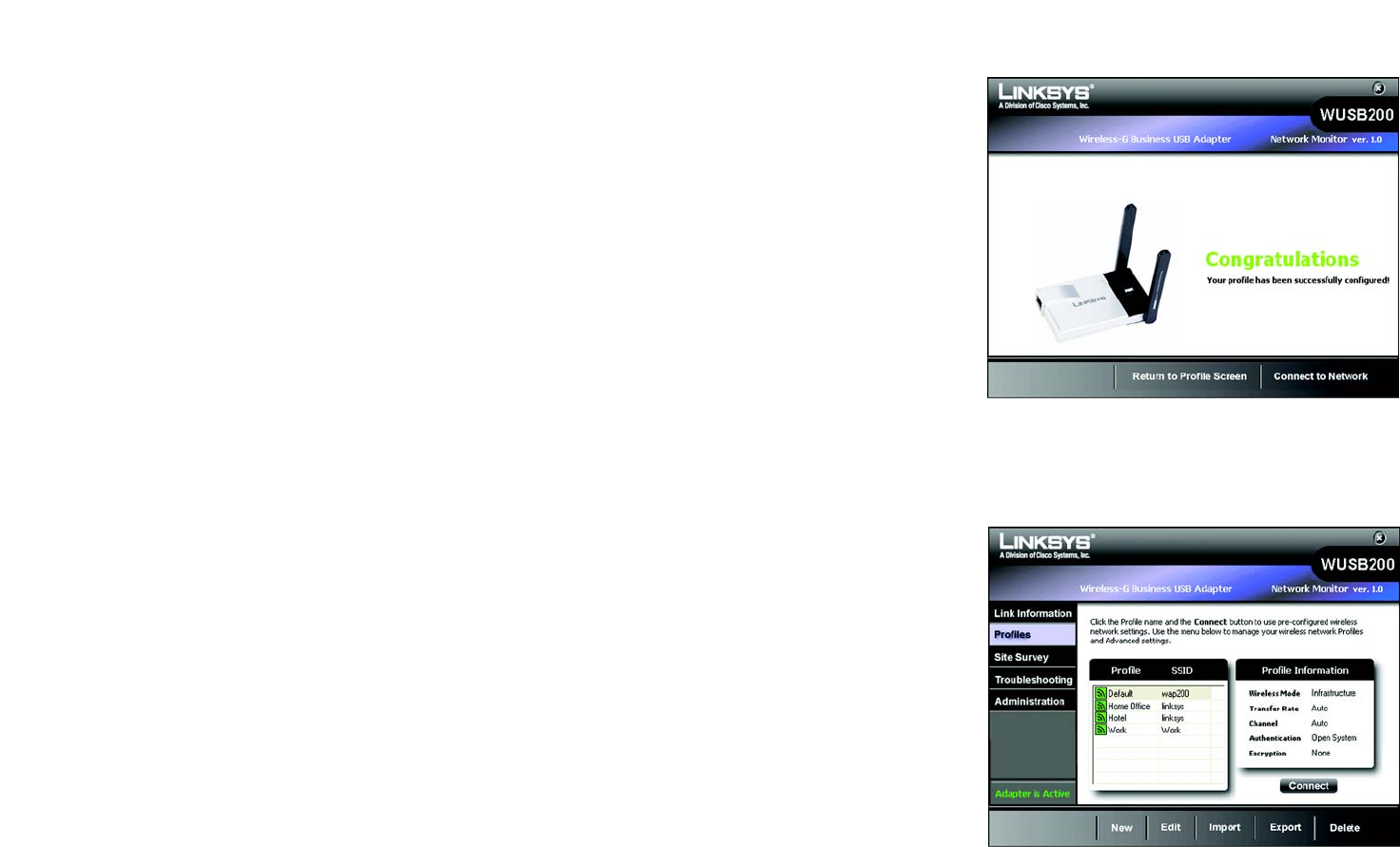
32
Chapter 5: Using the Wireless Network Monitor
Editing a Profile
Wireless-G Business USB Network Adapter with RangeBooster
7. The Congratulations screen will appear next. Click Connect to Network to implement the new settings
immediately and return to the Link Information screen. Click Return to Profile Screen to keep the current
settings active and return to the Profiles screen.
Congratulations! The profile has been successfully configured.
Editing a Profile
On the Profiles screen, select the profile that you would like to edit in the profile list and click on Edit button. The
next screen would be the Wireless Mode. Follow the steps below to complete the task.
Figure 5-26: Creating a Profile - Manual Setup -
Congratulations
Figure 5-27: Editing a Profile

33
Chapter 5: Using the Wireless Network Monitor
Editing a Profile
Wireless-G Business USB Network Adapter with RangeBooster
1. The Wireless Mode screen shows a choice of two wireless modes. Click the Infrastructure Mode radio
button if you want to connect to a wireless router or access point. Click the Ad-Hoc Mode radio button if you
want to connect to another wireless device directly without using a wireless router or access point. Enter the
SSID for your network.
Infrastructure Mode - Use this mode if you want to connect to a wireless router or access point.
Ad-Hoc Mode - Use this mode if you want to connect to another wireless device directly without using a
wireless router or access point.
SSID - This is the wireless network name that must be used for all the devices in your wireless network. It is
case- sensitive and should be a unique name to help prevent others from entering your network.
Click the Next button to continue, or click the Back button to return to the previous screen.
2. If you chose Infrastructure Mode, go to Step 3 now. If you chose Ad-Hoc Mode, the Ad-Hoc Mode Settings
screen will appear.
Select the correct operating channel for your wireless network. The channel you choose should match the
channel set on the other devices in your wireless network. If you are unsure about which channel to use, keep
the default setting.
Click the Next button. Click the Back button to change any settings.
Figure 5-28: Editing a Profile - Wireless Mode
Figure 5-29: Editing a Profile - Ad Hoc Mode

34
Chapter 5: Using the Wireless Network Monitor
Editing a Profile
Wireless-G Business USB Network Adapter with RangeBooster
3. If your wireless network doesn’t have wireless security, select Disabled and then click the Next button to
continue. Proceed to Step 4.
If your wireless network has wireless security, select the method of security used: WEP, WPA/WPA2
Personal, WPA/WPA2 Enterprise, RADIUS or LEAP. WEP stands for Wired Equivalent Privacy, and WPA
stands for Wi-Fi Protected Access. WPA uses a stronger security method than WEP and WPA2 defines an even
stronger encryption, authentication, and key management than WPA. RADIUS stands for Remote
Authentication Dial-In User Service. LEAP stands for Lightweight Extensible Authentication Protocol. It uses
username and password-based authentication between a wireless client and a RADIUS server. Click the Next
button to continue or the Back button to return to the previous screen.
Proceed to the appropriate section for your security method: WEP, WPA/WPA2-Personal, WPA/WPA2-
Enterprise, RADIUS, or LEAP.
WEP
WEP - Select 64-bit or 128-bit encryption
Passphrase - Enter a passphrase in the Passphrase field, so a WEP key is automatically generated. It is case-
sensitive and should not be longer than 16 alphanumeric characters. This passphrase must match the
passphrase of your other wireless network devices and is compatible with Linksys wireless products only. (If
you have any non-Linksys wireless products, enter the WEP key manually on those products.)
WEP Key - The WEP key you enter must match the WEP key of your wireless network. For 64-bit encryption,
enter exactly 10 hexadecimal characters. For 128-bit encryption, enter exactly 26 hexadecimal characters.
Valid hexadecimal characters are “0” to “9” and “A” to “F”.
Advanced Users
TX Key - The default transmit key number is 1. If your network’s access point or wireless router uses transmit
key number 2, 3, or 4, select the appropriate number from the TX Key drop-down box.
Authentication -The default is set to Auto, so it will auto-detect for Shared Key or Open System
authentication. For Shared Key authentication, both the sender and the recipient share a WEP key for
authentication. For Open System authentication, the sender and the recipient do not share a WEP key for
authentication. If you are not sure which authentication method to select, keep the default, Auto.
Click the Next button to continue, or click the Back button to return to the previous screen.
Figure 5-30: Editing a Profile - Wireless Security
Figure 5-31: Editing a Profile - Wireless Security -
WEP

35
Chapter 5: Using the Wireless Network Monitor
Editing a Profile
Wireless-G Business USB Network Adapter with RangeBooster
WPA Personal
WPA Personal offers two encryption methods, TKIP and AES, with dynamic encryption keys. WPA2 only uses
AES for encryption. Select TKIP or AES for encryption for WPA Personal. Then enter a Passphrase that is 8-63
characters in length.
Encryption - Select the type of algorithm you want to use, TKIP or AES, from the Encryption drop-down
menu.
Passphrase - Enter a Passphrase, also called a Pre-shared Key, of 8-63 characters in the Passphrase field.
Click the Next button to continue or the Back button to return to the previous screen.
WPA2 Personal
Enter a Pre-shared Key that is 8-63 characters in length.
Pre-shared Key - Enter a Pre-shared Key of 8-63 characters in the Pre-shared Key field.
Click the Next button to continue or the Back button to return to the previous screen.
Figure 5-32: Editing a Profile - Wireless Security -
WPA Personal
Figure 5-33: Editing a Profile - Wireless Security -
WPA2 Personal

36
Chapter 5: Using the Wireless Network Monitor
Editing a Profile
Wireless-G Business USB Network Adapter with RangeBooster
WPA Enterprise
WPA/WPA2 Enterprise features WPA security used in coordination with a RADIUS server. (This should only be
used when a RADIUS server is connected to the Router.) WPA Enterprise offers two authentication methods,
EAP-TLS and PEAP, as well as two encryption methods, TKIP and AES, with dynamic encryption keys. WPA2
Enterprise offers two authentication methods, EAP-TLS and PEAP, but only AES encryption method is used.
Authentication - Select the authentication method your network is using, EAP-TLS or PEAP.
EAP-TLS
If you selected EAP-TLS, enter the login name of your wireless network in the Login Name field. Enter the
name of the authentication server in the Server Name field (this is optional). From the Certificate drop-down
menu, select the certificate you have installed to authenticate you on your wireless network. Select the type
of encryption, TKIP or AES, from the Encryption drop-down menu.
Click the Next button to continue or the Back button to return to the previous screen.
PEAP
If you selected PEAP, enter the login name of your wireless network in the Login Name field. Enter the
password of your wireless network in the Password field. Enter the name of the authentication server in the
Server Name field (this is optional). From the Certificate drop-down menu, select the certificate you have
installed to authenticate you on your wireless network; if you want to use any certificate, keep the default
setting, Trust Any. Then select the authentication method used inside the PEAP tunnel. Select the type of
encryption, TKIP or AES, from the Encryption drop-down menu.
Click the Next button to continue or the Back button to return to the previous screen.
Figure 5-34: Editing a Profile - Wireless Security -
WPA Enterprise - EAP-TLS
Figure 5-35: Editing a Profile - Wireless Security -
WPA Enterprise - PEAP

37
Chapter 5: Using the Wireless Network Monitor
Editing a Profile
Wireless-G Business USB Network Adapter with RangeBooster
WPA2 Enterprise
WPA2 Enterprise features WPA2 security used in coordination with a RADIUS server. (This should only be used
when a RADIUS server is connected to the Router.) WPA2 Enterprise offers two authentication methods, EAP-
TLS and PEAP.
Authentication - Select the authentication method your network is using, EAP-TLS or PEAP.
EAP-TLS
If you selected EAP-TLS, enter the login name of your wireless network in the Login Name field. Enter the
name of the authentication server in the Server Name field (this is optional). From the Certificate drop-down
menu, select the certificate you have installed to authenticate you on your wireless network.
Click the Next button to continue or the Back button to return to the previous screen.
PEAP
If you selected PEAP, enter the login name of your wireless network in the Login Name field. Enter the
password of your wireless network in the Password field. Enter the name of the authentication server in the
Server Name field (this is optional). From the Certificate drop-down menu, select the certificate you have
installed to authenticate you on your wireless network; if you want to use any certificate, keep the default
setting, Trust Any. Then select the authentication method used inside the PEAP tunnel.
Click the Next button to continue or the Back button to return to the previous screen.
Figure 5-36: Editing a Profile - Wireless Security -
WPA2 Enterprise - EAP-TLS
Figure 5-37: Editing a Profile - Wireless Security -
WPA2 Enterprise - PEAP

38
Chapter 5: Using the Wireless Network Monitor
Editing a Profile
Wireless-G Business USB Network Adapter with RangeBooster
RADIUS
RADIUS features use of a RADIUS server. (This should only be used when a RADIUS server is connected to the
Router.) RADIUS offers two authentication types: EAP-TLS and PEAP.
Authentication - Select the authentication method your network is using, EAP-TLS or PEAP.
EAP-TLS
If you selected EAP-TLS, enter the login name of your wireless network in the Login Name field. Enter the
name of the authentication server in the Server Name field (this is optional). From the Certificate drop-down
menu, select the certificate you have installed to authenticate you on your wireless network.
Click the Next button to continue or the Back button to return to the previous screen.
PEAP
If you selected PEAP, enter the login name of your wireless network in the Login Name field. Enter the
password of your wireless network in the Password field. Enter the name of the authentication server in the
Server Name field (this is optional).
Click the Next button to continue or the Back button to return to the previous screen.
Figure 5-38: Editing a Profile - Wireless Security -
RADIUS - EAP-TLS
Figure 5-39: Editing a Profile - Wireless Security -
RADIUS - PEAP

39
Chapter 5: Using the Wireless Network Monitor
Editing a Profile
Wireless-G Business USB Network Adapter with RangeBooster
LEAP
Lightweight Extensible Authentication Protocol is a mutual authentication method that uses a username and
password based system.
Enter the username and password in the username and password field accordingly. Enter the password again
in the Confirm field.
4. The Network Settings screen from the Wireless Network Monitor will appear. If your network has a router or
other DHCP server, click the radio button next to Obtain network settings automatically (DHCP).
If your network does not have a DHCP server, click the radio button next to Specify network settings. Enter
an IP Address, Subnet Mask, Default Gateway, and DNS addresses appropriate for your network. You must
specify the IP Address and Subnet Mask on this screen. If you are unsure about the Default Gateway and DNS
addresses, leave these fields empty.
IP Address - This IP Address must be unique to your network.
Subnet Mask - The Adapter’s Subnet Mask must be the same as your wired network’s Subnet Mask.
Default Gateway - Enter the IP address of your network’s Gateway here.
DNS 1 and DNS 2 - Enter the DNS address of your wired Ethernet network here.
Click the Next button to continue, or click the Back button to return to the previous screen.
Figure 5-40: Editing a Profile - Wireless Security -
LEAP
Figure 5-41: Editing a Profile - Network Settings
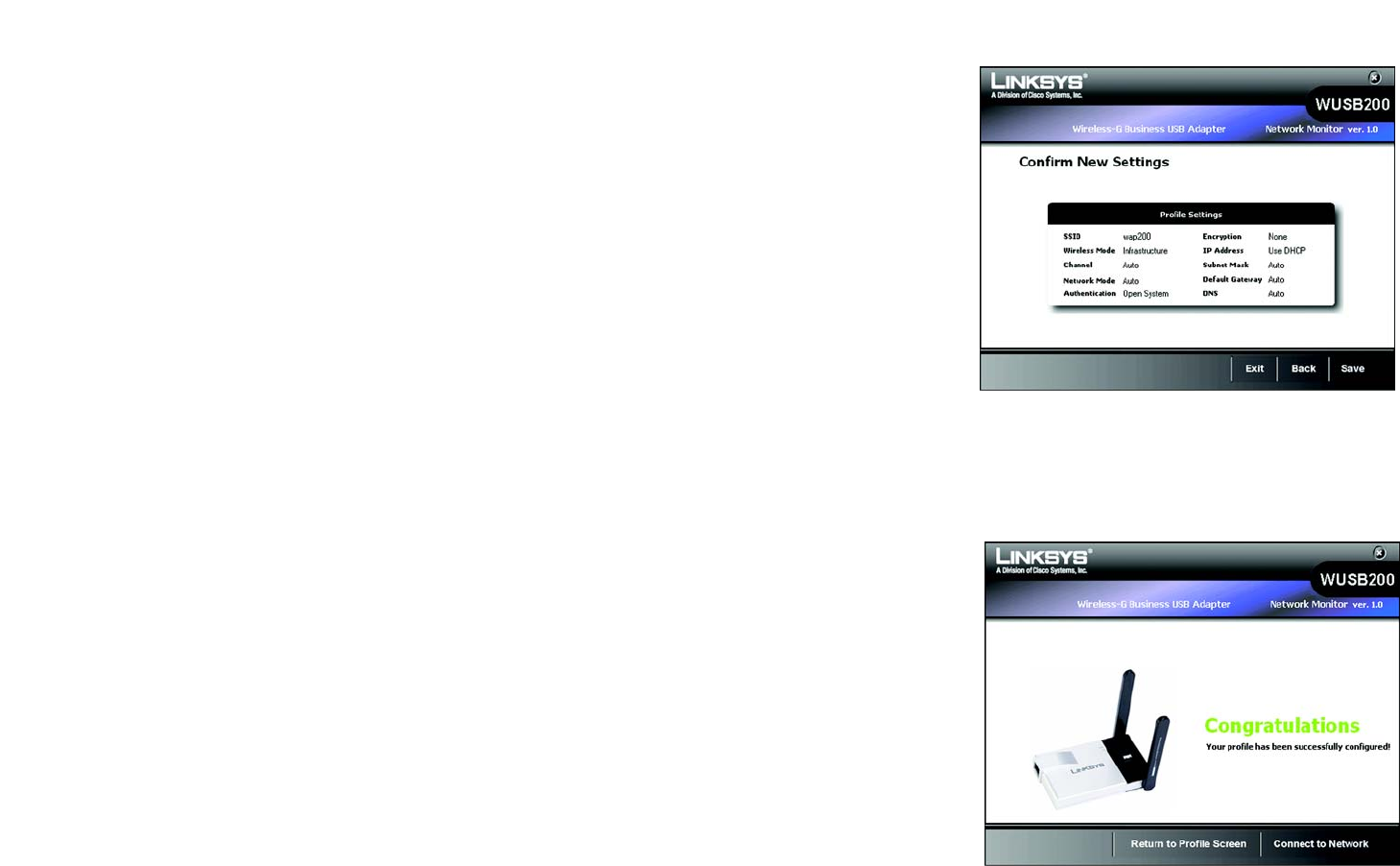
40
Chapter 5: Using the Wireless Network Monitor
Editing a Profile
Wireless-G Business USB Network Adapter with RangeBooster
5. The Confirm New Settings screen will appear next and show the new settings. To save the new settings, click
the Save button.
To edit the new settings, click the Back button. To exit the Manual Setup through the Wireless Network
Monitor, click Exit.
6. The Congratulations screen will appear next. Click Connect to Network to implement the new settings
immediately and return to the Link Information screen. Click Return to Profile Screen to keep the current
settings active and return to the Profiles screen.
Congratulations! The profile has been successfully configured.
Figure 5-43: Editing a Profile - Congratulations
Figure 5-42: Editing a Profile - Confirm New Settings
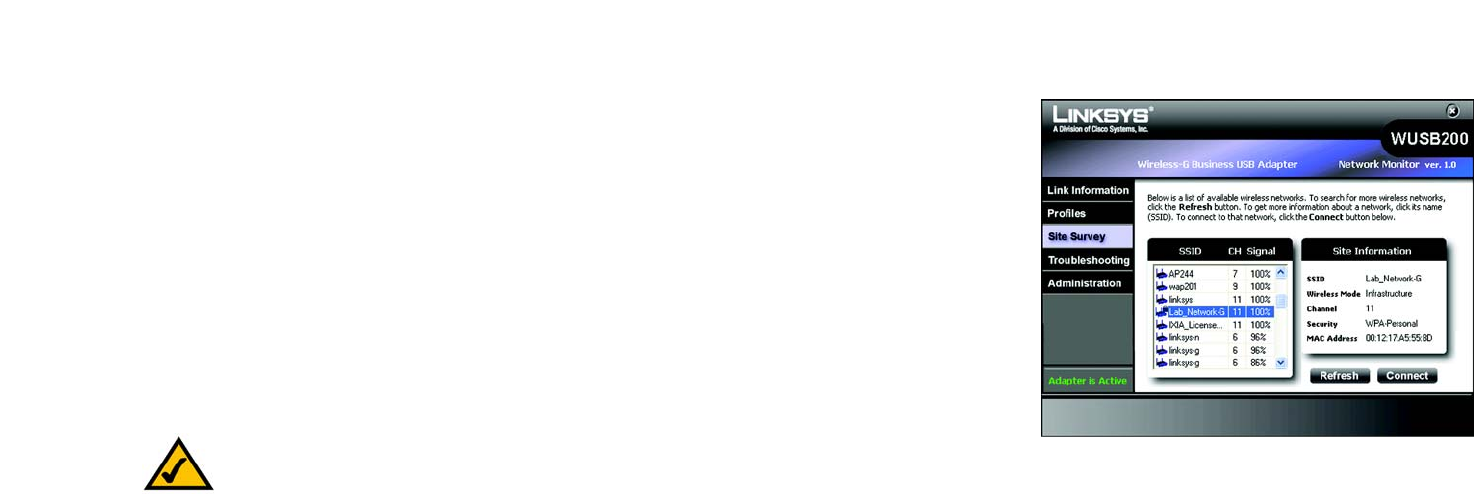
41
Chapter 5: Using the Wireless Network Monitor
Site Survey
Wireless-G Business USB Network Adapter with RangeBooster
Figure 5-44: Site Survey
Site Survey
The Site Survey screen displays a list of available networks in the table on the left. The table shows each
network’s SSID, Channel, and the quality of the wireless signal the Adapter is receiving. You may click SSID, CH
(Channel), or Signal, to sort by that field.
SSID - The SSID or unique name of the wireless network is displayed here.
CH - This is the channel that the network uses.
Signal - This is the percentage of signal strength, from 0 to 100%.
For more information about classification of the Access Points, refer to “AP Classification” section of “Chapter 6:
The Administrative Functions in the Wireless Network Monitor.”
Site Information
For each network selected, the following settings for each SSID are listed:
Wireless Mode - This is the mode of the wireless network currently in use.
Network Type - The type of your network connection in either wireless-b or wireless-g is displayed here.
Security - The status of the wireless security feature is displayed here.
MAC Address- The MAC address of the wireless network’s access point is displayed here.
Refresh - Click the Refresh button to perform a new search for wireless devices.
Connect - Click the Connect button to connect to a selected network.
The Access Points in the Site Survey list will be represented with different
icons that will indicate Access Points in various states of classification. For
instance, trusted Access Points are green, untrusted Access Points are red,
and unclassified Access Points are blue. And if there is a lock next to it, it
indicates the Access Point has a security method enabled.

42
Chapter 5: Using the Wireless Network Monitor
Troubleshooting
Wireless-G Business USB Network Adapter with RangeBooster
Troubleshooting
The Troubleshooting screen lets you troubleshoot your wireless connection.
Address Type - This shows the addressing method of your client.
IP Address - This shows the current IP Address of your client.
Subnet Mask - This shows the subnet mask of your IP addressing.
Default Gateway - This shows the default gateway of your IP addressing.
You may click Repair to troubleshoot your connection to the wireless network. Repair will disconnect your client
from the network and then reconnect, in order to re-establish an IP address. You may also click FAQ to view the
FAQ pages from the Linksys website.
Administration
The Administration screen lets you administer your Security Monitor account and classification functions, and
modify your Access Point’s username and password in Account Management. Select on a button to log in to
either the Security Monitor account or Account Management as the Access Point's administrator.
Log in to the Security Monitor account to access the classification and Security Monitor functions:
Enter the Security Monitor’s account name and password in the username and password fields, then retype the
password in the confirm field. Click Next to continue to the administrative options.
After a successful login, the Classification and Security Monitor tab appears. Only the login screens are provided
in this section. To use the Administration tab, continue to Chapter 6: The Administrative Functions in the Wireless
Network Monitor.
Figure 5-45: Troubleshooting
Figure 5-46: Administration

43
Chapter 5: Using the Wireless Network Monitor
Administration
Wireless-G Business USB Network Adapter with RangeBooster
Log in as the Access Point's administrator:
Enter the Access Point's administrative account and password and retype the password in the confirm field
(default account name is admin and password is admin). Click Next to continue to the administrative options.
Access Point Account
This screen appears when you click the Access Point button on the Security Monitor Account screen. This will let
you modify your Access Point’s username and password.
Figure 5-47: Administration - Login Access Point
Account
Figure 5-48: Administration - Modify Access Point
Account